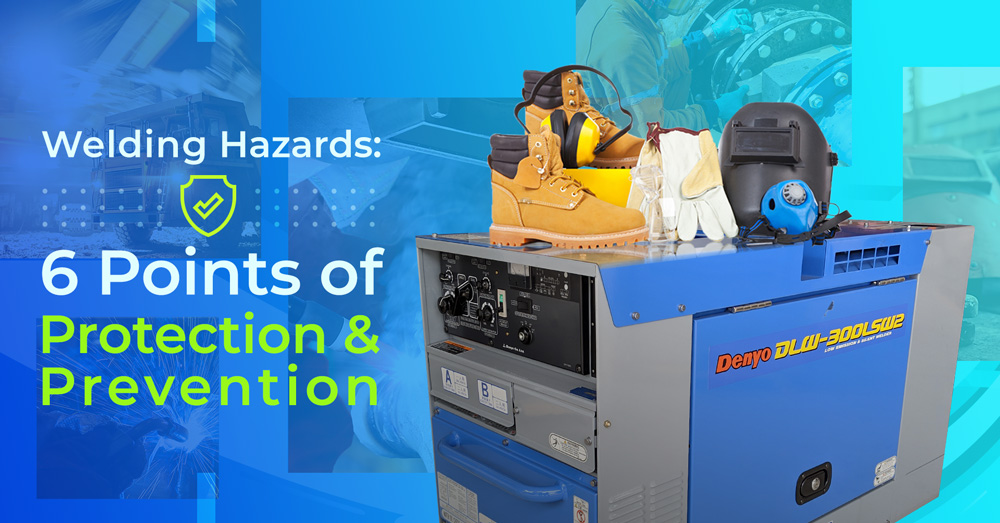Welding Hazards: 6 Points of Protection and Prevention

Welding is an integral aspect of building infrastructure. It is recognised as a method of repairing or creating metal structures by joining pieces of metals or plastic through various fusion processes — and modern metal fabrication wouldn’t be possible without welding.
However, any welding job comes with potential hazards. Arc welding operations are accompanied by the occurrence of spatter, fumes, intense light and noise; which harm the health of the welding technician. Therefore, it is important that you are aware of the hazards and understand what precautions you need to take to protect yourself.
Protection against Eye Injury
Arc welding emits a high volume of strong visible rays as well as ultraviolet (UV) or infrared rays that are harmful to the eyes. Looking directly at these rays, especially at UV rays, may result in a painful and sometimes long-lasting condition called arc-eye. This eye injury does not come with instant pain, but delay treatment or negligence of care may result in weak sight or eventual loss of sight.
To protect yourself from eye injuries:
- - Work site must be enclosed with light-shading curtains or screens.
- - Welding technicians must be protected with the use of welding helmet and light-shading goggles.
- - People within the vicinity of welding must be adequately protected if they are closer than 10 metres from an arc flash.1
Protection against Skin Injury
The combination of high-temperature welding arcs, UV rays and molten metal will cause severe burns. It is not uncommon to get burned due to splashed spatters and slag, but these burns are also extremely easy to prevent if proper precautions are taken.
To protect yourself from skin injuries:
- - Welding technicians should be protected by heat-resistant protectors including arm covers, aprons and foot covers.
- - Pants should not have cuffs and shirts should have flaps over pockets or be taped closed to avoid exposing the skin to the arc rays.
Protection against Fumes and Gases
Arc welding will expose you to hazardous gaseous fumes, including nitrogen oxides, ozone, nitric oxide, and carbon monoxide which can easily penetrate into your lungs. The quantity of these gases may be small, but if inhaled over time, the resultant damage can be severe.
To protect yourself against fumes and gases:
- - Ensure good ventilation (when undertaking welding activities) as it removes airborne gases and particles from your work site.
- - Have respiratory protection (gas mask) on standby if ventilation do not reduce exposures to safe levels.
Prevention of Fire Accidents
As mentioned earlier, welding will set off sparks, arcs and molten metal splatters which could potentially cause fires.
To prevent fires:
- - Remove all combustibles and dangerous materials from the work site before starting work. Wherever foreseeable, appropriate measures should be taken to avoid the spread of sparks, an explosion or fire. It is also necessary to have a fire extinguisher on hand.
- - In a welding work to repair drum cans, tanks or pipes, ensure complete removal of ignitable liquid, inflammable gas or steam contained in the vessel before operation.
Prevention of Electric Shock Accidents
During the arc welding process, live electrical circuits are used to create a pool of molten metal. Therefore, you might be at risk of experiencing an electric shock which could result in serious injuries and fatalities. Welding technicians should be protected against electric shock even if they inadvertently touch the charger.
To prevent electric shocks:
- - Check the cables and holders, insulations and earth connections in the welder.
- - Be careful with moisture and always put on a pair of insulating boots and gloves before welding.
- - Avoid welding in damp conditions or/and in wet clothing.
Prevention of Hearing Impairment
When carrying out welding activities, you are likely to be exposed to loud, prolonged noises. In general, noise levels above 85dB2 is considered harmful and welding process such as air carbon arc cutting and gouging can produce hazardous sound levels ranging between 108 and 120dB.3 This can be damaging to the ears and result in hearing impairment or loss.
To prevent exposures to loud noises:
- - Welding technicians must be equipped with proper hearing protection, such as ear muffs or fire-resistant foam ear plugs.
In this article, we have identified and explained the different hazards posed by welding. If you have more questions regarding welder handling or any operation related questions, feel free to contact us to address your concerns.


